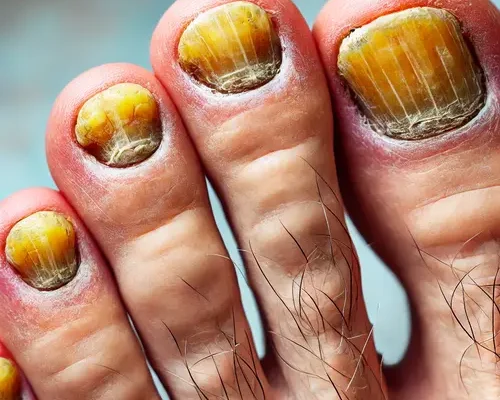Candidiasis of Skin and Nails

Maya, a 32-year-old woman, notices that her fingernails have become discolored, thickened, and unusually brittle. After trying over-the-counter remedies with little success, she visits her doctor, who diagnoses her with nail candidiasis. At the same time, Jason, a 45-year-old man, experiences persistent itching and redness between his fingers, and upon closer inspection, he finds small, red patches on his skin. His diagnosis? Candidiasis of the skin.
Symptom Breakdown: Recognizing Skin and Nail Candidiasis
Candidiasis is a fungal infection caused by Candida yeast, which naturally lives on the skin. However, when the balance of microorganisms in the body is disrupted, Candida can overgrow, leading to infection.
Common Symptoms of Candidiasis on the Skin:
- Red, itchy patches of skin, often in warm, moist areas like between fingers, under the breasts, or in skin folds.
- Small, white pustules or blisters that can burst and become sore.
- Peeling or cracked skin, particularly in affected areas.
Nail Candidiasis Symptoms:
- Discolored nails (yellow, brown, or white).
- Thickening and brittleness of the nails.
- Painful, swollen skin around the nail bed.
- In severe cases, nail separation from the nail bed.
If left untreated, these symptoms can worsen, leading to more discomfort and difficulty in daily activities.
Diagnostic Path: What Causes Candidiasis of the Skin and Nails?
There are several factors that can lead to the overgrowth of Candida. Here are the most common causes of candidiasis:
Information verified by the
iytmed.com team.
- Moisture and Humidity:
People who live in humid environments or frequently wear tight, non-breathable clothing are more prone to skin fungal infections. The moisture trapped against the skin creates an ideal environment for Candida to thrive. - Weakened Immune System:
Individuals with compromised immune systems, such as those with diabetes or HIV, are at greater risk for yeast infections on the skin and nails. In these cases, the body struggles to keep Candida under control. - Excessive Sweatingrong>:
Those who sweat heavily, such as athletes, may develop skin infections like candidiasis in areas where sweat accumulates, such as underarms or the groin area. - Prolonged Exposure to Water:
People who frequently immerse their hands or feet in water, such as dishwashers or swimmers, are at higher risk of developing fungal nail infections. Constant exposure weakens the skin and nails, allowing Candida to take hold. - Use of Antibiotics:
Extended use of antibiotics can upset the natural balance of bacteria and fungi on the skin, leading to fungal infections. This is because antibiotics kill beneficial bacteria, allowing yeast to overgrow.
r has-alpha-channel-opacity"/> Deep Dive: How Does Candida Spread on Skin and Nails?
The Candida fungus thrives in warm, damp environments, which is why skin folds, nail beds, and other moist areas are commonly affected. When these areas are continuously exposed to sweat, water, or humidity, the skin barrier weakens, making it easier for Candida to invade.
For those with weakened immune systems, such as people with autoimmune disorders or on immunosuppressive drugs, Candida can spread more easily. It’s important to identify these risk factors early on to prevent more severe fungal infections from developing.
Treatment Comparison: Getting Rid of Candidiasis of the Skin and Nails
There are several effective treatment options to combat fungal infections on the skin and nails. The best treatment depends on the severity and location of the infection.
- rong>Topical Antifungal Creams:
- Clotrimazole or miconazole creams are commonly prescribed to treat candidiasis on the skin. These creams help kill the Candida yeast and reduce inflammation and itching.
- For mild to moderate cases, applying an antifungal cream directly to the affected area for 1-2 weeks should be effective.
- Oral Antifungal Medications:
- For more severe infections or nail candidiasis, doctors may prescribe oral antifungals like fluconazole or itraconazole. These medications work systemically to clear the infection from within.
- Proper Hygiene and Dryness:
- Keeping affected areas clean and dry is crucial for recovery. After bathing or washing, thoroughly dry skin folds and nail beds to prevent moisture buildup.
- Avoid wearing tight, non-breathable clothing and opt for loose, moisture-wicking fabrics instead.
- Nail Care:
- Trim affected nails carefully and avoid nail polish, which can trap moisture and worsen the infection.
- In severe cases of nail infection, a doctor may recommend removing part of the nail to allow for better treatment penetration.
Outcome Story: Regaining Healthy Skin and Nails
Take the example of Karen, a 37-year-old woman who suffered from candidiasis under her arms and around her toenails. After visiting a dermatologist, she was prescribed a topical antifungal cream and advised to switch to breathable fabrics. Within two weeks, her skin had cleared up, and her toenails were showing signs of improvement.
Similarly, Ahmed, a 50-year-old
man working in a humid warehouse environment, found that by using an antifungal cream and switching to moisture-wicking socks, his foot candidiasis resolved in a matter of weeks. Both were able to return to their daily routines without the discomfort of constant itching and irritation.
How to Prevent and Treat Candidiasis of the Skin and Nails
Candidiasis of the skin and nails can be uncomfortable, but it’s treatable with proper care and hygiene. Identifying the risk factors—such as moisture, weakened immunity, or excessive sweating—and taking proactive steps can help prevent infections from occurring. Whether through antifungal medications, better hygiene practices, or adjustments to daily habits, you can effectively manage and eliminate Candida infections.
If you’re experiencing persistent redness, itching, or nail changes, consult a healthcare provider for accurate diagnosis and treatment. With the right care, you can restore your skin and nails to a healthy state.









